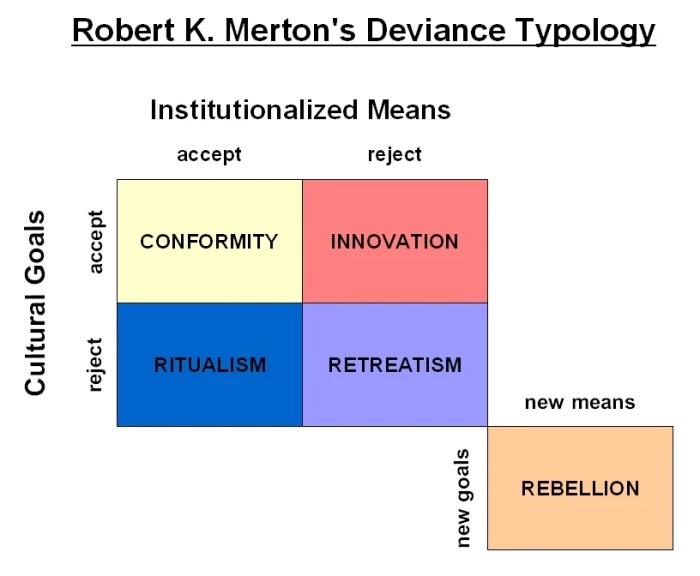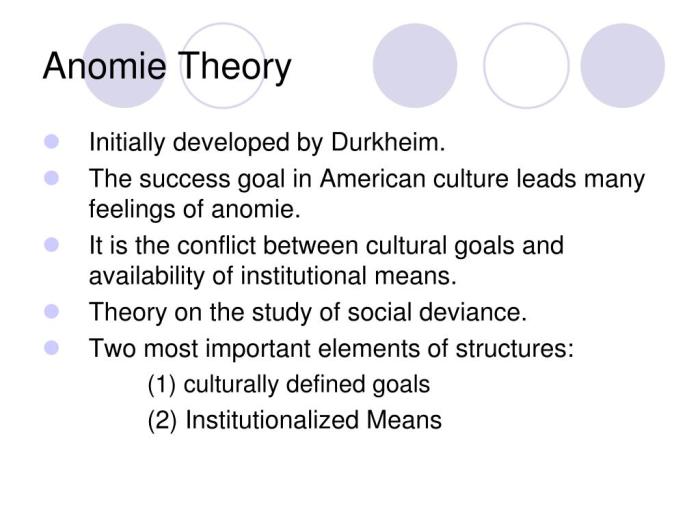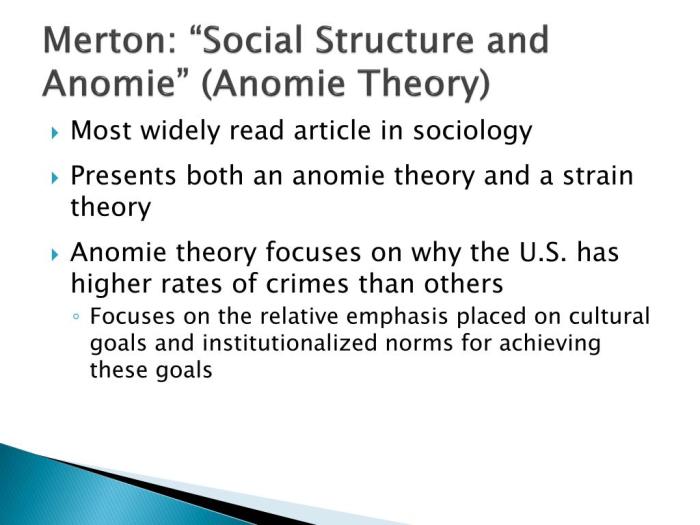Merton’s theory of anomie emphasizes the strain between culturally prescribed goals and the legitimate means of achieving them, leading to anomie, a state of normlessness and disorientation. This theory has significantly influenced sociological analysis, providing a framework for understanding social phenomena such as crime, deviance, and social inequality.
Merton’s theory posits that anomie arises when individuals are unable to achieve socially valued goals through legitimate means, resulting in strain. This strain can manifest in various modes of adaptation, including conformity, innovation, ritualism, retreatism, and rebellion.
1. Introduction

Merton’s theory of anomie emphasizes the relationship between social structure and deviant behavior. It proposes that when there is a discrepancy between culturally defined goals and the legitimate means to achieve them, individuals may experience strain and resort to deviant behavior as a way to cope.
This theory has significant relevance in sociological analysis, as it provides a framework for understanding the root causes of social problems and the role of social inequality in shaping individual behavior.
2. Key Components of Merton’s Theory

2.1 Structural Strain Theory
Merton’s structural strain theory argues that social structure can create strain for individuals who are unable to achieve culturally defined goals through legitimate means. This strain can lead to feelings of frustration, anger, and anomie, which can motivate individuals to engage in deviant behavior.
2.2 Relationship between Social Structure and Anomie, Merton’s theory of anomie emphasizes
Merton posits that anomie is a state of normlessness that arises when there is a disconnect between culturally defined goals and the legitimate means to achieve them. This disconnect can result from factors such as social inequality, economic disparities, and cultural changes.
2.3 Five Modes of Adaptation to Anomie
Merton identifies five modes of adaptation to anomie:
- Conformity: Accepting both cultural goals and legitimate means
- Innovation: Accepting cultural goals but rejecting legitimate means
- Ritualism: Rejecting cultural goals but adhering to legitimate means
- Retreatism: Rejecting both cultural goals and legitimate means
- Rebellion: Rejecting both cultural goals and legitimate means and replacing them with new ones
3. Applications of Merton’s Theory

Merton’s theory has been widely applied to explain various social phenomena, including:
- Crime and deviance: The theory suggests that individuals who experience strain due to blocked opportunities may turn to crime as a way to achieve their goals.
- Social inequality: The theory highlights the role of social inequality in creating strain and anomie, which can lead to increased rates of deviant behavior among disadvantaged groups.
- Social movements: Merton’s theory can be used to explain the emergence of social movements that seek to challenge existing cultural goals and legitimate means.
4. Criticisms and Extensions of Merton’s Theory
Merton’s theory has faced criticism for:
- Oversimplifying the relationship between social structure and deviance
- Ignoring the role of individual agency in shaping behavior
- Focusing primarily on structural factors while neglecting cultural and psychological factors
Subsequent research has extended and refined Merton’s theory, incorporating:
- Social learning theory: Emphasizing the role of learning and socialization in shaping deviant behavior
- Social control theory: Focusing on the role of social bonds and social institutions in preventing deviance
- Labeling theory: Highlighting the role of social labeling in shaping the self-concept and behavior of individuals
5. Contemporary Relevance of Merton’s Theory: Merton’s Theory Of Anomie Emphasizes

Merton’s theory remains relevant in contemporary society as it provides a framework for understanding:
- The impact of economic inequality and social stratification on crime and deviance
- The role of social media and technology in shaping cultural goals and legitimate means
- The emergence of new forms of deviant behavior in response to changing social conditions
By understanding the dynamics of anomie and its impact on individual behavior, Merton’s theory continues to be a valuable tool for sociologists and policymakers seeking to address social problems and promote social order.
User Queries
What is the central concept of Merton’s theory of anomie?
Merton’s theory of anomie focuses on the strain between culturally prescribed goals and the legitimate means of achieving them, leading to anomie, a state of normlessness and disorientation.
How does anomie affect social behavior?
Anomie can lead to various modes of adaptation, including conformity, innovation, ritualism, retreatism, and rebellion, as individuals seek to cope with the strain between goals and means.
What are the limitations of Merton’s theory of anomie?
Merton’s theory has been criticized for its overemphasis on structural factors and its neglect of individual agency and cultural influences.